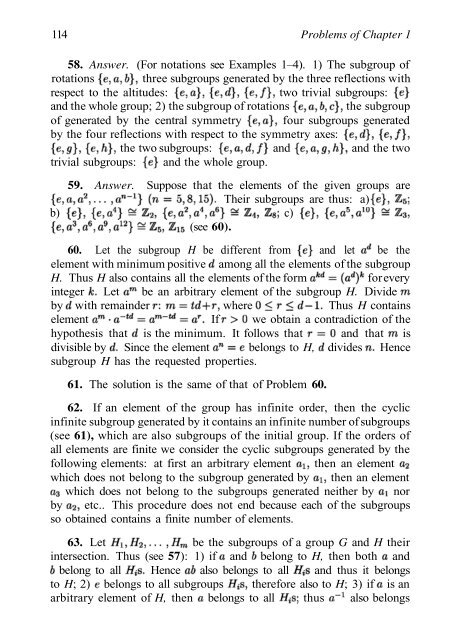Abel's theorem in problems and solutions - School of Mathematics
Abel's theorem in problems and solutions - School of Mathematics
Abel's theorem in problems and solutions - School of Mathematics
Create successful ePaper yourself
Turn your PDF publications into a flip-book with our unique Google optimized e-Paper software.
114 Problems <strong>of</strong> Chapter 1<br />
58. Answer. (For notations see Examples 1–4). 1) The subgroup <strong>of</strong><br />
rotations three subgroups generated by the three reflections with<br />
respect to the altitudes: two trivial subgroups:<br />
<strong>and</strong> the whole group; 2) the subgroup <strong>of</strong> rotations the subgroup<br />
<strong>of</strong> generated by the central symmetry four subgroups generated<br />
by the four reflections with respect to the symmetry axes:<br />
the two subgroups: <strong>and</strong> <strong>and</strong> the two<br />
trivial subgroups: <strong>and</strong> the whole group.<br />
59. Answer. Suppose that the elements <strong>of</strong> the given groups are<br />
Their subgroups are thus: a)<br />
b) c)<br />
(see 60).<br />
60. Let the subgroup H be different from <strong>and</strong> let be the<br />
element with m<strong>in</strong>imum positive among all the elements <strong>of</strong> the subgroup<br />
H. Thus H also conta<strong>in</strong>s all the elements <strong>of</strong> the form for every<br />
<strong>in</strong>teger Let be an arbitrary element <strong>of</strong> the subgroup H. Divide<br />
by with rema<strong>in</strong>der where Thus H conta<strong>in</strong>s<br />
element If we obta<strong>in</strong> a contradiction <strong>of</strong> the<br />
hypothesis that is the m<strong>in</strong>imum. It follows that <strong>and</strong> that is<br />
divisible by S<strong>in</strong>ce the element belongs to H, divides Hence<br />
subgroup H has the requested properties.<br />
61. The solution is the same <strong>of</strong> that <strong>of</strong> Problem 60.<br />
62. If an element <strong>of</strong> the group has <strong>in</strong>f<strong>in</strong>ite order, then the cyclic<br />
<strong>in</strong>f<strong>in</strong>ite subgroup generated by it conta<strong>in</strong>s an <strong>in</strong>f<strong>in</strong>ite number <strong>of</strong> subgroups<br />
(see 61), which are also subgroups <strong>of</strong> the <strong>in</strong>itial group. If the orders <strong>of</strong><br />
all elements are f<strong>in</strong>ite we consider the cyclic subgroups generated by the<br />
follow<strong>in</strong>g elements: at first an arbitrary element then an element<br />
which does not belong to the subgroup generated by then an element<br />
which does not belong to the subgroups generated neither by nor<br />
by etc.. This procedure does not end because each <strong>of</strong> the subgroups<br />
so obta<strong>in</strong>ed conta<strong>in</strong>s a f<strong>in</strong>ite number <strong>of</strong> elements.<br />
63. Let be the subgroups <strong>of</strong> a group G <strong>and</strong> H their<br />
<strong>in</strong>tersection. Thus (see 57): 1) if <strong>and</strong> belong to H, then both <strong>and</strong><br />
belong to all Hence also belongs to all <strong>and</strong> thus it belongs<br />
to H; 2) belongs to all subgroups therefore also to H; 3) if is an<br />
arbitrary element <strong>of</strong> H, then belongs to all thus also belongs

















